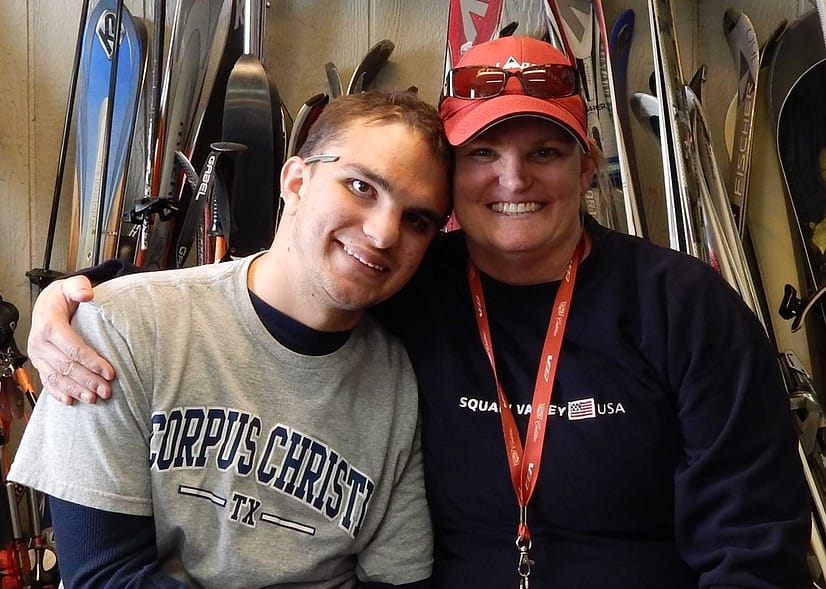The Reach of One Person Can Impact So Many
“I need to help that little girl up,” said Sean Marusich, after she careened into him on the beginner slope at Ski Apache.

As his Ski Apache Adaptive Sports (SAAS) coach gently reminded him that it was her fault, that she was skiing out of control and that she needed a lesson, Sean answered: “But everyone falls sometime, don’t they?”
It is difficult logic to argue with, made all the more significant since, nearly 12 years ago, doctors removed the entire right side of Sean’s brain.
Marusich was born with hemophilia A, a genetic disorder that neither of his parents knew ran in the family. Laura, Sean’s mother, is a carrier due to an intron 22 inversion mutation of the F8 gene that occurred in her genetic past. The recessive gene is present in 1 in every 5,000 male births. Females generally do not have the bleeding disorder, but are at risk of having an affected son.
Sean’s older sister may be a carrier and will be tested if and when she decides to start a family.
Sean skis with SAAS less for the hemophilia: his parents regularly infuse him with Factor VIII and, once he intravenously receives the drug, the likelihood from severe bleeding is minimal. The reason Sean needs a one-on-one coach is for the neurological damage he suffered after a brain bleed that occurred when he was a baby. At three days old, doctors told Laura and Erich, her husband and Sean’s father, that Sean would be blind, deaf and have severe mental difficulties.
While Sean was does not have these disabilities, he did experience 40 to 50 seizures a day.
“There were times when Erich and I thought he was having one long seizure,” Laura said. “He had no quality of life.”
Since the massive brain bleed affected that lobe’s ability to form, doctors in Houston recommended the hemispherectomy when Sean was six years old.
It is a procedure championed by Dr. Ben Carson in the 1980s at John Hopkins Hospital.
“It was the scariest thing my husband and I ever faced,” Laura said. “It was a nine-hour operation, and he is the only known severe hemophiliac to undergo or survive an operation of this magnitude. We were told that even with contingencies, there was no guarantee that Sean would survive, because he may bleed out.”
After the procedure, Laura, who is a licensed physical therapist, worked with Sean. An athlete herself, she understands firsthand the benefits of physical activity and building muscle and coordination, especially for those children with hemophilia.
“Many end up having knee replacements in their teens because they have suffered so many spontaneous bleeds into their joints,” Laura explained. “No trauma is needed for a hemophiliac to bleed, so we’ve worked on building strong muscles surrounding Sean’s joints through therapy and sports.”
Talking with other families with children with hemophilia, the question of how much a family should expose their children to risk ultimately comes up for the Marusichs.
“People ask: ‘What if he falls?’ but Erich and I both are able to administer Factor VIII,” Laura said. “If he were to have a bad fall or hit his head, we’d infuse him again and he’d have plenty of protection. Our philosophy is: ‘Are we going to hold him back from all of this stuff or are we going to live life?’”
Sean started skiing at Ski Apache with a walker mounted on skis, but now, coaches at SAAS are working to teach him to use more of his left side to initiate turns using just a bungee to hold the tips of his skis together. He has difficulty twisting his left foot, but can turn by twisting both hips.
The Marusichs supplement skiing with horseback riding and golf. Sean competes in Special Olympics and has a personal trainer. A special recumbent bike with levers mounted on the right side and the ability for Sean to clip in both feet was built. The family also enjoys jet-skiing and riding ATVs.
He also has interests outside of the physical realm.
Today, Sean is looking forward to graduating high school is enrolled in the marketing program at the Center for Career and Technology Education. He has a job lined up as a mail runner for an El Paso law firm.
Contrary to conventional thought that the right side of the brain controls the creative side, Sean enjoys and excels at both painting and drawing.
“I’ve painted horses and birds,” said Sean. “I’m working on a real large painting now. It is on an easel, and I have to stand up to reach the top.”
It is this excitement about life and his cheerful and helping manner that strike a person first meeting Sean. He is also proud of doing things himself.
That independence does not mean that Sean is self-absorbed or egocentric.
“He’s a pleaser and always has been,” Laura said. “Even before the operation, if Sean saw a kid alone on the playground, he’d immediately go over to play with that child. He wants to make people happy.”
That trait was obvious as he took off his skis and walked with a determined, albeit limping, gait to that little girl lying in the snow.
When the coach relayed the story to Laura, she laughed.
“There was a neuro-psychologist that told me in Sean’s post-op that I wasn’t going to see any changes,” Laura said. “I asked her: ‘You aren’t a mother, are you?’ Every day he is happy, and he touches everyone he meets. He is truly a gift.”